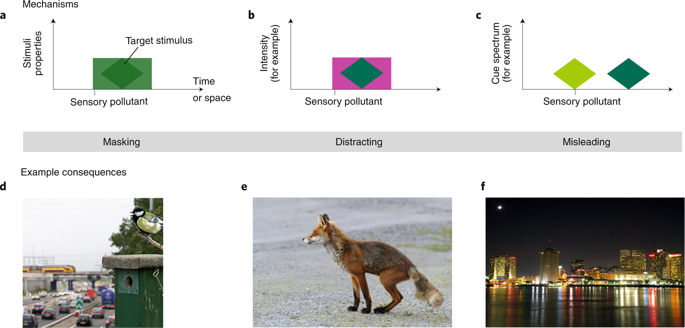Nature Ecology & Evolution ( IF 13.9 ) Pub Date : 2020-03-16 , DOI: 10.1038/s41559-020-1135-4 Davide M Dominoni 1, 2 , Wouter Halfwerk 3 , Emily Baird 4 , Rachel T Buxton 5 , Esteban Fernández-Juricic 6 , Kurt M Fristrup 7 , Megan F McKenna 7 , Daniel J Mennitt 8 , Elizabeth K Perkin 9 , Brett M Seymoure 5 , David C Stoner 10 , Jennifer B Tennessen 11 , Cory A Toth 12 , Luke P Tyrrell 13 , Ashley Wilson 14 , Clinton D Francis 14 , Neil H Carter 15 , Jesse R Barber 16

|
Global expansion of human activities is associated with the introduction of novel stimuli, such as anthropogenic noise, artificial lights and chemical agents. Progress in documenting the ecological effects of sensory pollutants is weakened by sparse knowledge of the mechanisms underlying these effects. This severely limits our capacity to devise mitigation measures. Here, we integrate knowledge of animal sensory ecology, physiology and life history to articulate three perceptual mechanisms—masking, distracting and misleading—that clearly explain how and why anthropogenic sensory pollutants impact organisms. We then link these three mechanisms to ecological consequences and discuss their implications for conservation. We argue that this framework can reveal the presence of ‘sensory danger zones’, hotspots of conservation concern where sensory pollutants overlap in space and time with an organism’s activity, and foster development of strategic interventions to mitigate the impact of sensory pollutants. Future research that applies this framework will provide critical insight to preserve the natural sensory world.
中文翻译:

为什么保护生物学可以从感官生态中受益。
人类活动的全球扩展与新型刺激的引入有关,例如人为噪声,人造光和化学制剂。对感官污染物的生态效应进行记录的进展因对这些效应潜在机理的了解不足而受到削弱。这严重限制了我们制定缓解措施的能力。在这里,我们整合了动物感官生态学,生理学和生活史的知识,以阐明三种感知机制(掩盖,分散注意力和误导),这些机制清楚地解释了人为感官污染物如何以及为何影响生物。然后,我们将这三种机制与生态后果联系起来,并讨论它们对保护的意义。我们认为该框架可以揭示“感官危险区”的存在,保护关注的热点,即感官污染物在空间和时间上与生物体的活动重叠,并促进发展战略干预措施以减轻感官污染物的影响。将来应用此框架的研究将提供关键的见解,以保护自然的感官世界。











































 京公网安备 11010802027423号
京公网安备 11010802027423号